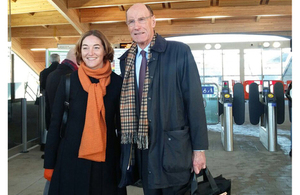Thames Estuary 2050 Growth Commission priorities confirmed
The priorities of the Thames Estuary 2050 Growth Commission include equipping people with the right skills, and providing high quality housing.

Sir John Armitt, Chair of the Thames Estuary 2050 Growth Commission, and Professor Sadie Morgan, Deputy Chair
The priorities of the Thames Estuary 2050 Growth Commission, which include equipping people with the right skills and providing high quality housing, have been announced during a visit by the new Chair and Deputy Chair.
Sir John Armitt, who was announced as the new Chair at the Budget, visited Bexley to outline the Commission’s areas of focus for the coming months. The Commission’s final report, which will lay out recommendations to government, will be published in spring 2018.
Sir John, who is former Chair of the Olympic Delivery Authority, replaces the former Government Advisor on Local Growth, Lord Heseltine, who stepped down from the Commission in March 2017. He is joined by Deputy Chair, Professor Sadie Morgan, co-founding director at the award-winning practice, dRMM Architects.
Sajid Javid, Secretary of State for Communities and Local Government, said:
It’s long been known that the Thames Estuary has vast economic potential and, as a government, we’re determined to capitalise on this for the benefit of local communities and national growth.
The Commission, benefitting from refreshed leadership, will now build on its vision to unleash growth and boost productivity.
Sir John Armitt, Chair of the Thames Estuary 2050 Growth Commission, said:
I welcome the opportunity to lead this vital piece of work. I look forward to engaging with all stakeholders to produce a compelling vision and delivery plan for this exciting area, which I believe can help drive the UK’s economic growth.
Professor Sadie Morgan, Deputy Chair of the Thames Estuary 2050 Growth Commission, said:
With a combined population of over three million and no shortage of great ideas, the Thames Estuary is brimming with opportunities. I am delighted to be supporting Sir John in helping all stakeholders to realise the exceptional potential of this region.
The Commission will draw together and develop existing plans into a vision to stimulate future growth for decades to come. I have a strong affinity with the Thames Estuary, having lived in the area all my life, and so look forward to being a part of this exciting journey.
The Commission will now focus on the following priorities:
-
Sectors – creating internationally-competitive centres of excellence that build on the corridor’s sector strengths, for example in ports and logistics, and making the most of growth sectors such as the creative industries
-
Connectivity – making the most of planned investments such as the Lower Thames Crossing, and assessing the case for other investments that have been proposed, such as further river crossings and extending the Elizabeth Line to Ebbsfleet
-
Communities – ensuring that people right across the corridor benefit from expected growth, including equipping them with the right skills, making sure high-quality housing is available, promoting use of the river, and enhancing the Thames Estuary’s natural environment
-
Delivery – working closely with organisations and communities to develop a plan for delivering the vision, aligning with the Government’s intention to explore ambitious housing deals in the area.
Since it was established in March 2016, The Thames Estuary 2050 Growth Commission has been working to develop an ambitious vision and delivery plan for North Kent, South Essex and East London up to 2050. Home to 3.8 million people, the Thames Estuary is on the doorstep of both London and continental Europe, and has the potential to support growth right across the country. It also faces some real challenges, including significant pockets of deprivation.
Further information
The Commission ran a call for ideas from July to September 2016. There were over 100 respondents, including public, private and third sector organisations, and members of the public. The Commission has also held visits to the Thames Estuary, including along the river itself. Both the Commission and the government are grateful to all those who have provided input, and are committed to delivering a compelling vision and delivery plan in close collaboration with a wide range of partners.
Sir John Armitt is Chair of the National Express Group and the City & Guilds Group, Deputy Chair of the Berkeley Group and the National Infrastructure Commission. He is a Fellow of the Royal Academy of Engineering, the Institution of Civil Engineers and City & Guilds of London Institute. He was awarded the CBE in 1996 for his contribution to the rail industry and a knighthood in 2012 for services to engineering and construction.
Professor Sadie Morgan is a co-founding director at the award-winning practice, dRMM Architects. She became the youngest and only third ever-female President of the Architectural Association in 2013. In March 2015, Sadie was appointed as Design Chair for High Speed Two (HS2) reporting directly to the Secretary of State. She is also a member of the National Infrastructure Commission.
Office address and general enquiries
2 Marsham StreetLondon
SW1P 4DF
Contact form https://www.gov.uk/gui...
General enquiries: please use this number if you are a member of the public 030 3444 0000
If your enquiry is related to COVID-19 please check our guidance page first before you contact us - https://www.gov.uk/guidance/coronavirus-covid-19-guidance-for-local-government.
If you still need to contact us please use the contact form above to get in touch, because of coronavirus (COVID-19). If you send it by post it will not receive a reply within normal timescale.
Media enquiries
Email newsdesk@communities.gov.uk
Please use this number if you are a journalist wishing to speak to Press Office 0303 444 1209
Social media - MHCLG
Twitter - https://twitter.com/mhclg
Flickr - http://www.flickr.com/photos/mhclg
LinkedIn - http://www.linkedin.com/company/mhclg